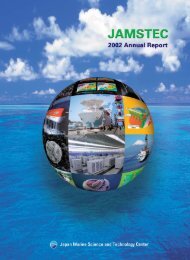2007 Annual Report - jamstec japan agency for marine-earth ...
2007 Annual Report - jamstec japan agency for marine-earth ...
2007 Annual Report - jamstec japan agency for marine-earth ...
Create successful ePaper yourself
Turn your PDF publications into a flip-book with our unique Google optimized e-Paper software.
the western North Pacific brought most of the rainfall over<br />
Thailand in September. TCs include tropical depressions, tropical<br />
storms, severe tropical storms, typhoons, and residual lows.<br />
70% of the rainfall amount in September was estimated to be<br />
associated with TCs.<br />
The 50-year time-series of September rainfall over<br />
Thailand showed a significant decreasing trend. TC activity<br />
defined by 700-hPa relative vorticity, showed a weakening<br />
trend over the Indochina Peninsula Fig.3. TC tracks also<br />
suggested the weakening of TC activity over this area. The<br />
long-term trend in rainfall during the late summer monsoon season<br />
was closely associated with changes in TC activity over the<br />
Indochina Peninsula; these changes were likely caused by<br />
changes in the major course of TCs Fig.3. Concurrent with<br />
the changes in TC tracks, there was a change in the TC steering<br />
investigated by AGCM using the global vegetation maps since<br />
1700 Ramankutty and Foley, 1999; Hirabayashi et al.,<br />
2005. In 1700-1850, impacts of human-induced increases in<br />
greenhouse gases and aerosols were negligible. There<strong>for</strong>e cultivation<br />
was the major anthropogenic disturbance to the climate<br />
in that period. The cultivated areas in Asia <strong>for</strong> 1700-1850 were<br />
the Indian subcontinent and China. Surface albedo was<br />
increased and surface roughness was decreased due to land<br />
cover/use change, leading to changes in evaporation and water<br />
vapor convergence in those regions. As a result, monsoon precipitation<br />
was reduced in those regions, particularly in the<br />
Indian subcontinent, from 1700 to 1850 Fig.4. This result<br />
is consistent with the estimation of long-term changes in Indian<br />
monsoon precipitation by Himalayan glacier ice-cores.<br />
Takata et al., PNAS, to be submitted<br />
current around the Philippines archipelago and Taiwan. This led<br />
to the TC activity over the Indochina Peninsula being inactive,<br />
probably resulting in the long-term decrease in rainfall over<br />
Thailand. Takahashi and Yasunari, 2008, JMSJ<br />
Fig.4 June-August mean changes from 1700 to 1850.<br />
a) Preciptaion (shades in mm/day) and water vapor flux at 850 hPa (unit<br />
vector in2/s). b) Albedo (shades) and surface air temperature at 2 m<br />
(contours in K).<br />
b. Land-Surface Hydrological Cycle Process Group<br />
b-1. Examination of the water budget in the Yellow River basin<br />
In this study, we describe a hydrological model that considers<br />
five categories of land use. Calibration and verification of<br />
the model were carried out at two independent watersheds<br />
Tangnaihai, 120,000 km 2 and Lushi, 6,400 km 2 . The model<br />
results represent the hydrographs and annual runoffs at two<br />
Fig.3 upper panel Scatterplot between September rainfall over<br />
Thailand and TC day defined by 700-hPa relative vorticity. Rectangle, circle,<br />
and star symbols indicate the relationship in each year during P1<br />
1958-65, P21966-80, and P31981-95, respectively. The crosses<br />
labeled P1, P2, and P3 show the mean relationship of each period.<br />
lower panel Distribution of TC-appearance frequencies during P1<br />
1958-1965 and P31981-95. Unit is times per month.<br />
gauge stations over a relatively long-term period 18 years at<br />
Tangnaihai and 21 years at Lushi. The Nash-Sutcliffe efficiency<br />
coefficients <strong>for</strong> monthly discharge were 0.87 at<br />
Tangnaihai <strong>for</strong> the period of 1980-1997 and 0.84 at Lushi <strong>for</strong><br />
the period of 1980-2000. The model was applied to other watersheds<br />
of the Yellow River basin above Huayuankou station, and<br />
a-3. Evaluation of impacts of land cover/use change by cultivation<br />
in pre-industrial period on Asian monsoon climate<br />
Impacts of Land cover/use change by cultivation on Asian<br />
monsoon climate in the pre-industrial period, 1700-1850, was<br />
water budget components in each region were analyzed. Water<br />
use <strong>for</strong> agricultural irrigation was stable throughout the entire<br />
simulation period. A numerical experiment of water conservation<br />
<strong>for</strong> the whole basin above Huayuankou station demonstrat-
















